Weiqiang Wang
OmniAgent: Audio-Guided Active Perception Agent for Omnimodal Audio-Video Understanding
Dec 29, 2025Abstract:Omnimodal large language models have made significant strides in unifying audio and visual modalities; however, they often lack the fine-grained cross-modal understanding and have difficulty with multimodal alignment. To address these limitations, we introduce OmniAgent, a fully audio-guided active perception agent that dynamically orchestrates specialized tools to achieve more fine-grained audio-visual reasoning. Unlike previous works that rely on rigid, static workflows and dense frame-captioning, this paper demonstrates a paradigm shift from passive response generation to active multimodal inquiry. OmniAgent employs dynamic planning to autonomously orchestrate tool invocation on demand, strategically concentrating perceptual attention on task-relevant cues. Central to our approach is a novel coarse-to-fine audio-guided perception paradigm, which leverages audio cues to localize temporal events and guide subsequent reasoning. Extensive empirical evaluations on three audio-video understanding benchmarks demonstrate that OmniAgent achieves state-of-the-art performance, surpassing leading open-source and proprietary models by substantial margins of 10% - 20% accuracy.
TraPO: A Semi-Supervised Reinforcement Learning Framework for Boosting LLM Reasoning
Dec 15, 2025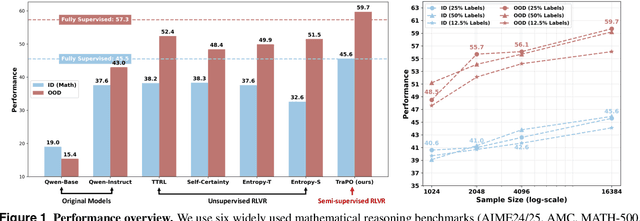
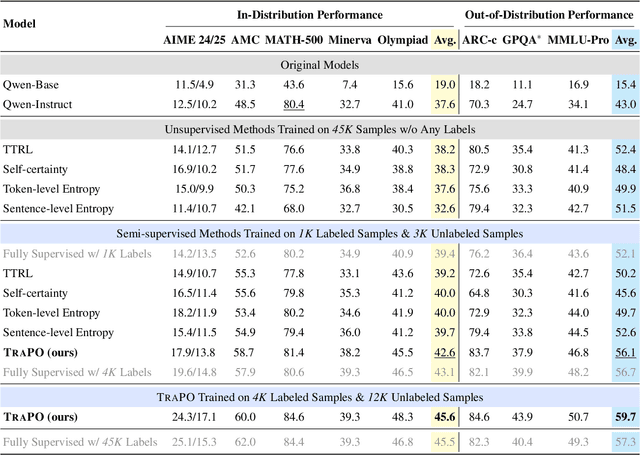
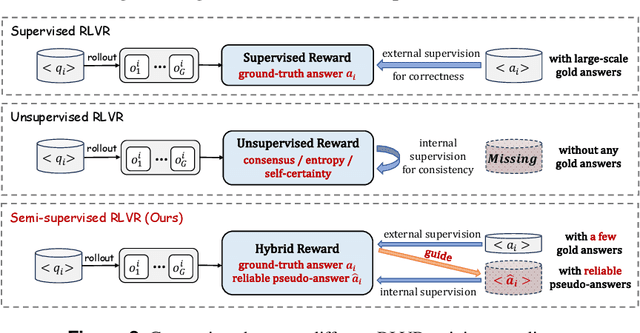
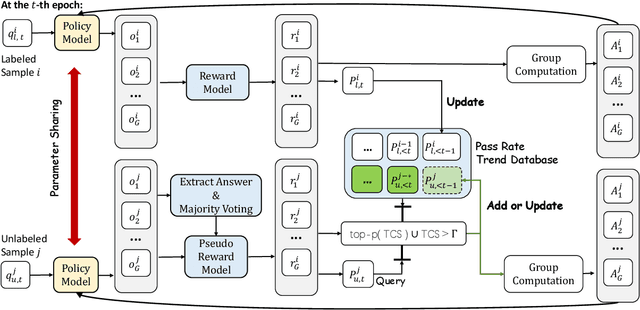
Abstract:Reinforcement learning with verifiable rewards (RLVR) has proven effective in training large reasoning models (LRMs) by leveraging answer-verifiable signals to guide policy optimization, which, however, suffers from high annotation costs. To alleviate this problem, recent work has explored unsupervised RLVR methods that derive rewards solely from the model's internal consistency, such as through entropy and majority voting. While seemingly promising, these methods often suffer from model collapse in the later stages of training, which may arise from the reinforcement of incorrect reasoning patterns in the absence of external supervision. In this work, we investigate a novel semi-supervised RLVR paradigm that utilizes a small labeled set to guide RLVR training on unlabeled samples. Our key insight is that supervised rewards are essential for stabilizing consistency-based training on unlabeled samples, ensuring that only reasoning patterns verified on labeled instances are incorporated into RL training. Technically, we propose an effective policy optimization algorithm, TraPO, that identifies reliable unlabeled samples by matching their learning trajectory similarity to labeled ones. Building on this, TraPO achieves remarkable data efficiency and strong generalization on six widely used mathematical reasoning benchmarks (AIME24/25, AMC, MATH-500, Minerva, and Olympiad) and three out-of-distribution tasks (ARC-c, GPQA-diamond, and MMLU-pro). With only 1K labeled and 3K unlabeled samples, TraPO reaches 42.6% average accuracy, surpassing the best unsupervised method trained on 45K unlabeled samples (38.3%). Notably, when using 4K labeled and 12K unlabeled samples, TraPO even outperforms the fully supervised model trained on the full 45K labeled samples on all benchmarks, while using only 10% of the labeled data. The code is available via https://github.com/ShenzhiYang2000/TRAPO.
StreamingAssistant: Efficient Visual Token Pruning for Accelerating Online Video Understanding
Dec 14, 2025Abstract:Online video understanding is essential for applications like public surveillance and AI glasses. However, applying Multimodal Large Language Models (MLLMs) to this domain is challenging due to the large number of video frames, resulting in high GPU memory usage and computational latency. To address these challenges, we propose token pruning as a means to reduce context length while retaining critical information. Specifically, we introduce a novel redundancy metric, Maximum Similarity to Spatially Adjacent Video Tokens (MSSAVT), which accounts for both token similarity and spatial position. To mitigate the bidirectional dependency between pruning and redundancy, we further design a masked pruning strategy that ensures only mutually unadjacent tokens are pruned. We also integrate an existing temporal redundancy-based pruning method to eliminate temporal redundancy of the video modality. Experimental results on multiple online and offline video understanding benchmarks demonstrate that our method significantly improves the accuracy (i.e., by 4\% at most) while incurring a negligible pruning latency (i.e., less than 1ms). Our full implementation will be made publicly available.
KBQA-R1: Reinforcing Large Language Models for Knowledge Base Question Answering
Dec 10, 2025Abstract:Knowledge Base Question Answering (KBQA) challenges models to bridge the gap between natural language and strict knowledge graph schemas by generating executable logical forms. While Large Language Models (LLMs) have advanced this field, current approaches often struggle with a dichotomy of failure: they either generate hallucinated queries without verifying schema existence or exhibit rigid, template-based reasoning that mimics synthesized traces without true comprehension of the environment. To address these limitations, we present \textbf{KBQA-R1}, a framework that shifts the paradigm from text imitation to interaction optimization via Reinforcement Learning. Treating KBQA as a multi-turn decision process, our model learns to navigate the knowledge base using a list of actions, leveraging Group Relative Policy Optimization (GRPO) to refine its strategies based on concrete execution feedback rather than static supervision. Furthermore, we introduce \textbf{Referenced Rejection Sampling (RRS)}, a data synthesis method that resolves cold-start challenges by strictly aligning reasoning traces with ground-truth action sequences. Extensive experiments on WebQSP, GrailQA, and GraphQuestions demonstrate that KBQA-R1 achieves state-of-the-art performance, effectively grounding LLM reasoning in verifiable execution.
OmniZip: Audio-Guided Dynamic Token Compression for Fast Omnimodal Large Language Models
Nov 18, 2025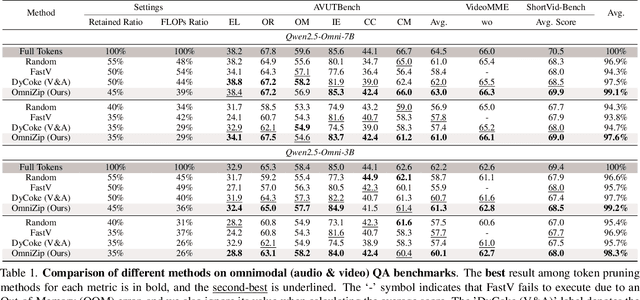
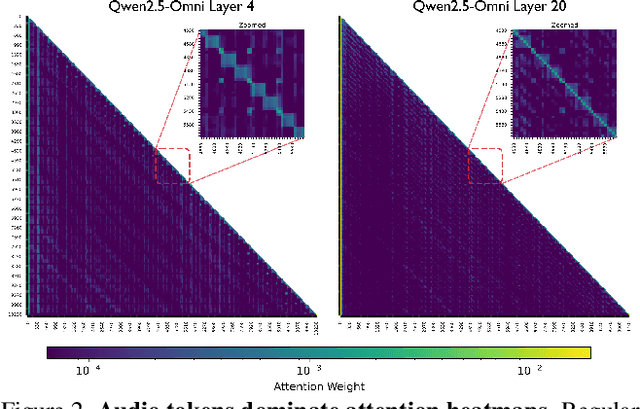


Abstract:Omnimodal large language models (OmniLLMs) have attracted increasing research attention of late towards unified audio-video understanding, wherein processing audio-video token sequences creates a significant computational bottleneck, however. Existing token compression methods have yet to accommodate this emerging need of jointly compressing multimodal tokens. To bridge this gap, we present OmniZip, a training-free, audio-guided audio-visual token-compression framework that optimizes multimodal token representation and accelerates inference. Specifically, OmniZip first identifies salient audio tokens, then computes an audio retention score for each time group to capture information density, thereby dynamically guiding video token pruning and preserving cues from audio anchors enhanced by cross-modal similarity. For each time window, OmniZip compresses the video tokens using an interleaved spatio-temporal scheme. Extensive empirical results demonstrate the merits of OmniZip - it achieves 3.42X inference speedup and 1.4X memory reduction over other top-performing counterparts, while maintaining performance with no training.
AiEDA: An Open-Source AI-Aided Design Library for Design-to-Vector
Nov 08, 2025Abstract:Recent research has demonstrated that artificial intelligence (AI) can assist electronic design automation (EDA) in improving both the quality and efficiency of chip design. But current AI for EDA (AI-EDA) infrastructures remain fragmented, lacking comprehensive solutions for the entire data pipeline from design execution to AI integration. Key challenges include fragmented flow engines that generate raw data, heterogeneous file formats for data exchange, non-standardized data extraction methods, and poorly organized data storage. This work introduces a unified open-source library for EDA (AiEDA) that addresses these issues. AiEDA integrates multiple design-to-vector data representation techniques that transform diverse chip design data into universal multi-level vector representations, establishing an AI-aided design (AAD) paradigm optimized for AI-EDA workflows. AiEDA provides complete physical design flows with programmatic data extraction and standardized Python interfaces bridging EDA datasets and AI frameworks. Leveraging the AiEDA library, we generate iDATA, a 600GB dataset of structured data derived from 50 real chip designs (28nm), and validate its effectiveness through seven representative AAD tasks spanning prediction, generation, optimization and analysis. The code is publicly available at https://github.com/OSCC-Project/AiEDA, while the full iDATA dataset is being prepared for public release, providing a foundation for future AI-EDA research.
Veritas: Generalizable Deepfake Detection via Pattern-Aware Reasoning
Aug 28, 2025



Abstract:Deepfake detection remains a formidable challenge due to the complex and evolving nature of fake content in real-world scenarios. However, existing academic benchmarks suffer from severe discrepancies from industrial practice, typically featuring homogeneous training sources and low-quality testing images, which hinder the practical deployments of current detectors. To mitigate this gap, we introduce HydraFake, a dataset that simulates real-world challenges with hierarchical generalization testing. Specifically, HydraFake involves diversified deepfake techniques and in-the-wild forgeries, along with rigorous training and evaluation protocol, covering unseen model architectures, emerging forgery techniques and novel data domains. Building on this resource, we propose Veritas, a multi-modal large language model (MLLM) based deepfake detector. Different from vanilla chain-of-thought (CoT), we introduce pattern-aware reasoning that involves critical reasoning patterns such as "planning" and "self-reflection" to emulate human forensic process. We further propose a two-stage training pipeline to seamlessly internalize such deepfake reasoning capacities into current MLLMs. Experiments on HydraFake dataset reveal that although previous detectors show great generalization on cross-model scenarios, they fall short on unseen forgeries and data domains. Our Veritas achieves significant gains across different OOD scenarios, and is capable of delivering transparent and faithful detection outputs.
Careful Queries, Credible Results: Teaching RAG Models Advanced Web Search Tools with Reinforcement Learning
Aug 11, 2025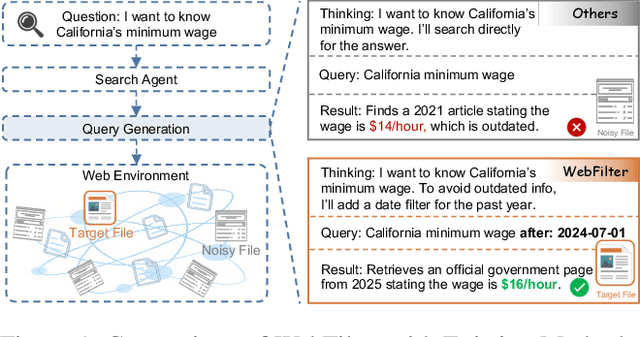

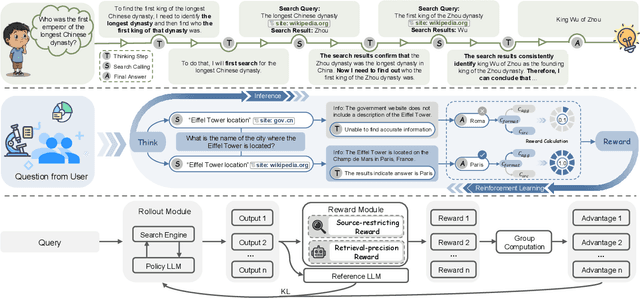
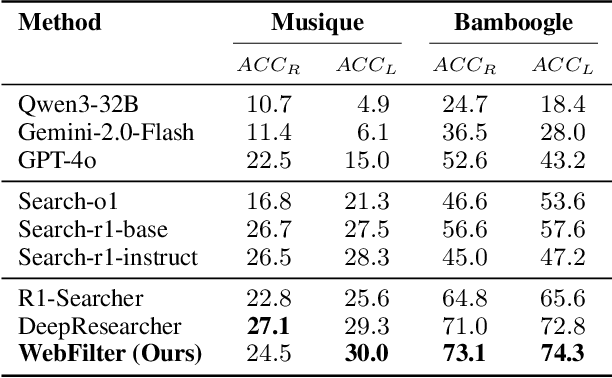
Abstract:Retrieval-Augmented Generation (RAG) enhances large language models (LLMs) by integrating up-to-date external knowledge, yet real-world web environments present unique challenges. These limitations manifest as two key challenges: pervasive misinformation in the web environment, which introduces unreliable or misleading content that can degrade retrieval accuracy, and the underutilization of web tools, which, if effectively employed, could enhance query precision and help mitigate this noise, ultimately improving the retrieval results in RAG systems. To address these issues, we propose WebFilter, a novel RAG framework that generates source-restricted queries and filters out unreliable content. This approach combines a retrieval filtering mechanism with a behavior- and outcome-driven reward strategy, optimizing both query formulation and retrieval outcomes. Extensive experiments demonstrate that WebFilter improves answer quality and retrieval precision, outperforming existing RAG methods on both in-domain and out-of-domain benchmarks.
Improved Personalized Headline Generation via Denoising Fake Interests from Implicit Feedback
Aug 10, 2025Abstract:Accurate personalized headline generation hinges on precisely capturing user interests from historical behaviors. However, existing methods neglect personalized-irrelevant click noise in entire historical clickstreams, which may lead to hallucinated headlines that deviate from genuine user preferences. In this paper, we reveal the detrimental impact of click noise on personalized generation quality through rigorous analysis in both user and news dimensions. Based on these insights, we propose a novel Personalized Headline Generation framework via Denoising Fake Interests from Implicit Feedback (PHG-DIF). PHG-DIF first employs dual-stage filtering to effectively remove clickstream noise, identified by short dwell times and abnormal click bursts, and then leverages multi-level temporal fusion to dynamically model users' evolving and multi-faceted interests for precise profiling. Moreover, we release DT-PENS, a new benchmark dataset comprising the click behavior of 1,000 carefully curated users and nearly 10,000 annotated personalized headlines with historical dwell time annotations. Extensive experiments demonstrate that PHG-DIF substantially mitigates the adverse effects of click noise and significantly improves headline quality, achieving state-of-the-art (SOTA) results on DT-PENS. Our framework implementation and dataset are available at https://github.com/liukejin-up/PHG-DIF.
* Accepted by the 34th ACM International Conference on Information and Knowledge Management (CIKM '25), Full Research Papers track
VS-LLM: Visual-Semantic Depression Assessment based on LLM for Drawing Projection Test
Aug 07, 2025Abstract:The Drawing Projection Test (DPT) is an essential tool in art therapy, allowing psychologists to assess participants' mental states through their sketches. Specifically, through sketches with the theme of "a person picking an apple from a tree (PPAT)", it can be revealed whether the participants are in mental states such as depression. Compared with scales, the DPT can enrich psychologists' understanding of an individual's mental state. However, the interpretation of the PPAT is laborious and depends on the experience of the psychologists. To address this issue, we propose an effective identification method to support psychologists in conducting a large-scale automatic DPT. Unlike traditional sketch recognition, DPT more focus on the overall evaluation of the sketches, such as color usage and space utilization. Moreover, PPAT imposes a time limit and prohibits verbal reminders, resulting in low drawing accuracy and a lack of detailed depiction. To address these challenges, we propose the following efforts: (1) Providing an experimental environment for automated analysis of PPAT sketches for depression assessment; (2) Offering a Visual-Semantic depression assessment based on LLM (VS-LLM) method; (3) Experimental results demonstrate that our method improves by 17.6% compared to the psychologist assessment method. We anticipate that this work will contribute to the research in mental state assessment based on PPAT sketches' elements recognition. Our datasets and codes are available at https://github.com/wmeiqi/VS-LLM.
 Add to Chrome
Add to Chrome Add to Firefox
Add to Firefox Add to Edge
Add to Edge